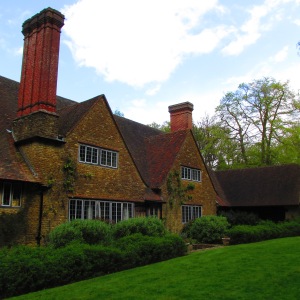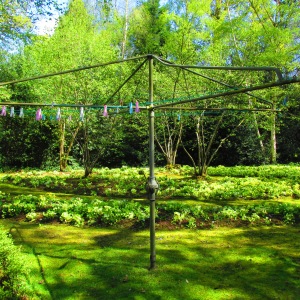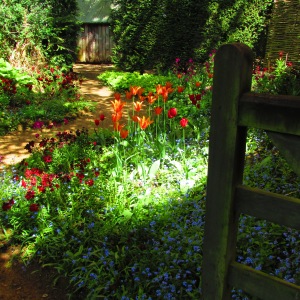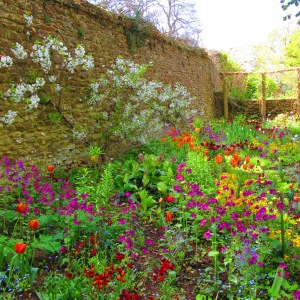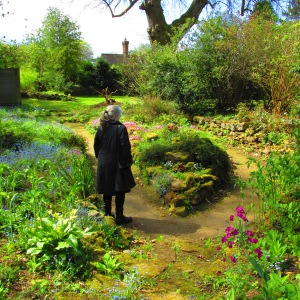Upon the sandy soil of Surrey heath stands a hut. Not just any hut, but the one that Gertrude Jekyll called home for many years: Munstead Wood. The house she nicknamed The Hut was designed by Edwin Lutyens and was set in the gardens she had already begun to develop.
An opportunity to visit is not to be missed. I went at the end of April as part of a group organised by The Garden Historians, and was not disappointed. Though some of the land was sold off in 1948 and split into different properties and several features of the garden lost or interrupted, the spirit of Miss Jekyll persists.
The garden is compartmentalised into areas of sequential interest, a kind of horticultural fuse, each area flashing into flower and colour before a transition to the next in the seasonal order. In late April, the Primrose Garden was only just on the wane. The famed ‘Munstead Bunch’ that Jekyll took many year to breed are no longer found among these Spinkies, but they were still a cheery sight. I loved the prosaic whirligig standing proud, almost like sculpture.
Meanwhile, the Spring Garden was full of oomph. Stepping through the five-bar gate, a polychromatic greeting extended. The first glimpse was of garnet wallflowers and orange tulips emerging from puddles of forget-me-nots….
….Turning around, the blue faded and the bolder colours overtook. Here, Tulipa bloomed in a range of colours from tangerine and burgundy to scarlet and white. Pink Honesty dotted around (the white sort is found elsewhere in the gardens), mingled with pale yellow wallflowers. Interspersed amongst all of this were Fritillaria imperialis, their whorls of flowers in both the orange and luteous forms. No space was wasted: across the path, in a shady spot congested with tree roots was situated Trachystemon orientalis, a relative of borage, with large, rough leaves useful for providing textural contradistinction.
The Long Border has yet to reveal its splendour. At 200 feet in length, it demonstrates Jekyll’s genius both in colour arrangement and in successional planting, for this herbaceous stretch flowers from July into October – no mean feat. In this, as in other areas, can be seen the spiky outlines of Yucca, for instance, contrasting with the more rounded shadow of Choisya. People often associate Jekyll with a fluffy, romantic cottage style, but she was not afraid to utilise exotic, spiky-looking plants for their different textures.
Another point of interest was the drastically pruned Magnolia conspicua, which had become too big and storm-battered. Its reduction will allow for the planting of delphiniums, given the influx of extra light. This treatment illustrates the dilemmas of restoring a garden: whilst keeping true to Jekyll’s planting schemes, there are other, pragmatic, elements requiring consideration. Munstead is a fragmented garden, and it would be difficult to restore it to its original state. There is the presence of the swimming pool which intersects Jekyll’s Nut Walk, for example. And not all areas of her Munstead are obvious: the Sunken Garden has only recently been rediscovered , but the location of the Secret Garden remains a mystery
The visit was rounded off with a trip to Jekyll’s grave in the local churchyard. On her stone is carved: ARTIST GARDENER CRAFTSWOMAN, a reminder of just how talented this woman was. Not just a gardener with a painterly eye, but skilled in silversmithing, carpentry, photography, drystone walling.. the list goes on. Truly a representative of the Arts and Crafts movement.
My thanks to head gardener, Annabel Watts, who conducted such an engaging tour.

